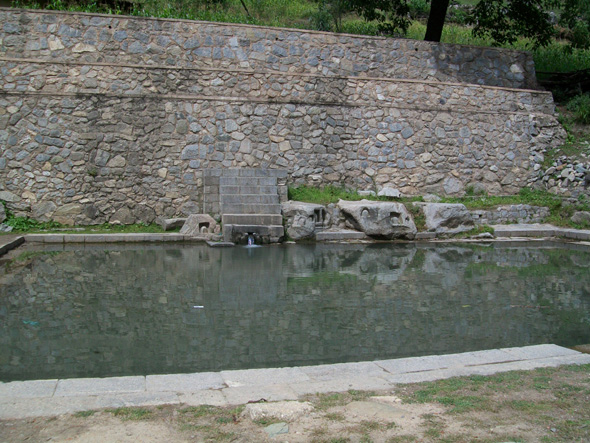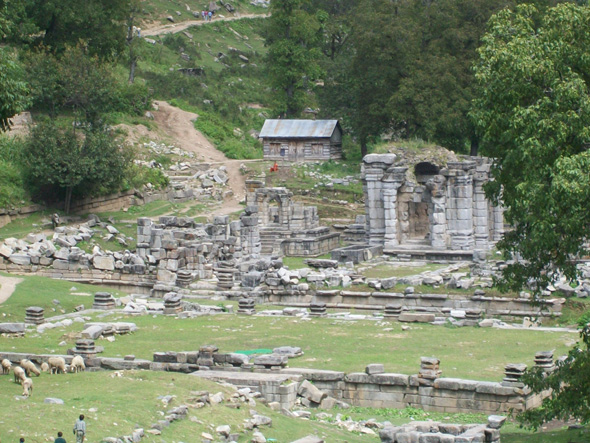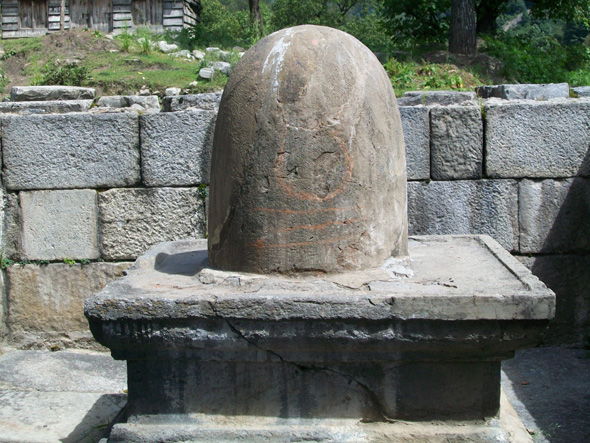Naran Nag
by Chander Bhat
Wangath is a place near Naran Nag, in the
Sindh Valley, and is ahead of Kangan; district Srinagar (now district Ganderbal)
is famous for cluster of ancient temples, now in ruins, of Bhuteshwara,
Jesthrudra and others. The temples are located at the foot of the steep
Bhuteshwara, near Naran Nag, 5 km to the North of Wangat, in a dense forest
of pine and fir trees in the lap of Harmukh Mountain. Formally known as
Sodaratirth, it is the location of temples commonly referred to as the
Wangath temples. The 12th century Bhutesvara temple erected by King
Jayasimha is the prime attraction. The ancient name of Wangath was Vashisht
Ashram.

Naran Nag
Neelmata repeatedly makes mention
of Bhuteshwara Teertha or Sodar Naag or Sodar Teertha.
Kalhana too makes repeated mention of Sodar Naag or Naran Nag
in Rajtarangini. To quote Taranga I canto 107 and 347, Taranga II
canto 123 and 139 and Taranga IV canto 189, he too calls it
Bhuteshwara or Bhutesha and Sodar Teertha. Again the spring
inside this temple complex is referred to as Sodar Naag by him. Kalhana
makes it clear that this temple complex was patronized by various kings of
Kashmir. King Jaluka (137 BC) erected a stone temple at this site dedicated to
Shiva Bhutesha. Kalhana adds that King Jayendra (61 BC) would come to worship
Shiva Bhutesha at this temple complex. King Lalitaditya (713-735 AD) donated a
good sum of money to this shrine after one of his victory expeditions. King
Avantivarman (855-883 AD) built a stone pedestal with silver conduit at this
shrine for bathing of sacred images. Kalhan’s family was also devoted to this
Teertha. His father Canpaka paid frequent visits to this shrine. Kalhana’s uncle
Kanka also happened to be a frequent visitor to this shrine. The Teertha
had a large number of Purohits who were paid handsome salaries from the
endowments created for the shrine. As per Kalhana, the treasury of this shrine
was plundered by King Sangramraja of Kashmir (1003-28 AD).
According to Lawrence, “in
antiquity these ruins are supposed to rank next after those of Bumzu and Payech”.
According to the scriptures, Naran Nag, in earlier times, was pilgrimages centre
and was famous as Sodara Tirtha. With the passage of time the shrine must
have lost its importance but it is said that pilgrims to Gangabal Tirtha
continued to pay obeisance at this pilgrimage centre. This ancient shrine has a
holy spring called Naran Nag, which has given the name Naran Nag to the
locality. In the vicinity of the holy spring are found ruins of the temples,
which have got buried almost completely and on the top of the largest, a pine
tree has taken the roots. A footpath by the side of holy springs leads on to the
height of Harmukh and to the height of Harmukh and to the
mountain-lake Gangabal, a celebrated place of pilgrimage, 5,000 feet
further up at the foot of Harmukh Mountain. It is said that Raja Narendraditya
built the small temples. According to Lawrence, “It is probable that the Wangath
temples were erected at different times by the returning pilgrims as votive
offering after successful accomplishment of the hazardous ascent”. The
surprising aspect about the temples is the fact that the material with which the
stones of the temple have been joined is not known. Major Cole places the time
of these temples as 1 AD.

Temple Complex
The structure of two clusters with six and
eleven temples even though now in ruins are by and large a perfect example of
Vastu Shastra as the back of these temples is towards the green hills which
is treated as the most auspicious on account of Vastu Shastra philosophy.
Each of the temple was built by perfect grafting of Devri Stones and
matches to the masonry of Bumzu, Awantipora, Parihaspur, Pattan and
Mattan temples. Its sanctity was of the highest level as all Kashmiri Pandits
held it in held esteem. The wall behind the clusters measuring 176 feet in
length and 130 feet in width probably also dates back to the era of temple. The
material used to erect the structures is yet to be established as the structures
have felt less effect of time and nature. The largest temple among the cluster
of temples was a grabgrah holding the site of Lord Shiva or
Bhuteshwara. The temple had two entrances one facing the rising sun and
other the setting sun. This gives an idea that if there is entry from rising sun
there is exit from the side of setting sun. It is also a philosophical point
that every dawn is followed by the dusk.

Shiva Lingam
The next philosophy of the doors from sun rise
and sun set is that the person entering during the time of sun rise could come
out through the door of sun at the time of sun set if he wished to visit all the
temples in the cluster. There is also a plinth wall measuring 100 feet by 67
feet and appears that this might have been a base of a magnificent structure.
The visit to this temple was
carried out me in the company of Shri Rakesh Sayal. Inspector Post Offices,
North Sub Division, Srinagar and Shri Jagan Nath Bhat, Accountant, General Post
Office, Srinagar on 10.09.2010 [the day of Eid] when there was mass agitation in
the valley in view of reported desecration of Holy Quran by a Christian Zealot
in United States. Rocks and stones were being rained by the protestors and
security forces were doing their best to keep them at bay. Under these trying
circumstances I had to travel all the way from Srinagar to Wangath and back. It
was an odyssey and a triumph to keep the next generation aware of our golden
culture.
Notes and References:
-
Place Names in Kashmir by
B.K.Raina & S.L.Sadhu, published by Bharatiya Vidya Bhavan, Mumbai & Indira
Gandhi National Centre for Arts, New Delhi, 2000.
-
Encyclopedia: Kashmiri Pandit:
Culture & Heritage by C.L.Kaul, published by Ansh Publications, 2009.
-
Ancient Monuments of Kashmir by
Ram Chand Kak, published by Aryan Books International, New Delhi, 2000.
-
Kalhan’s Rajatarangini….A
Chronicle of the Kings of Kashmir, Vol: II by Stein, Aurel, published by
Motilal Banarasi Dass, 1979.
-
Sodaratiratha: Myth, Legend and
History [Research Paper] by Dr. Ramesh Kumar Tamiri.
Image Gallery:
http://ikashmir.net/gallery/categories.php?cat_id=246
| 